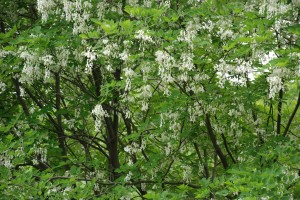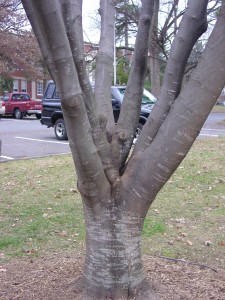American yellowwood (Cladrastis kentukea) is a beautiful native tree which is rarely planted in U.S. landscapes (USDA hardiness zones 4-8). Yellowwood is a tree for all seasons. It is both a lovely shade and flowering specimen. Long white wisteria-like flowers appear in mid- to late-May. It eventually matures into a lovely 35 to 45 foot landscape tree.
Yellowwood develops a narrow upright branching stance; its light gray smooth bark is very beech-like. Tree branches low to the ground. White fragrant pea-like blossoms, 8-14 inch long, drip from the tips of branches like wisteria. New spring compound leaf foliage starts off pale green, turns medium green by early summer, and turns lemony yellow in the fall. Each compound leaf is comprised of 7-leaflets, each 3-4 inches long. The species name is derived from the yellow color of its inner heartwood.
Yellowwood is the perfect tree for the patient gardener who is willing to wait 5-6 years (sometimes longer) after planting for first flowers to appear. The tree does not flower every spring and no one can predict what factors trigger the blooming response.
Plant this mid-sized tree around sunny patios and terrace areas, and take advantage of its cooling summer shade. Yellowwood prefers a moist, well-drained soil and is not drought tolerant. The species is pH insensitive and frequently grows in limestone-based soils. Disease and insect pests are rare, and do irrigate tree during periods of severe drought stress.
Yellowwood tree forms a deep legume root system; plant balled and burlapped (b&b) in late winter to early spring or container-grown nursery stock in any season. Prune in summer to avoid excess sap leakage observed in winter pruned trees. As the tree ages, upright branching sometimes leads to limb breakage. Main branches of older specimen trees may be cabled or braced to avoid or postpone limb loss.
‘Perkins’ Pink’, a rare pale pink flowering cultivar, is available from a few e-commerce nurseries.



 Posted in
Posted in 
